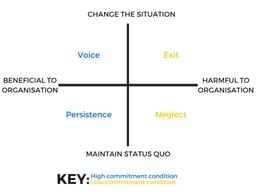 In our last blog, Put Your Worst Foot Forward – 2 of 4 Reasons it Works, we shared two reasons it’s actually more effective to adopt powerless communication to accentuate flaws in your idea.
In our last blog, Put Your Worst Foot Forward – 2 of 4 Reasons it Works, we shared two reasons it’s actually more effective to adopt powerless communication to accentuate flaws in your idea.
This story is taken from Adam Grant’s Originals.
Please refer to Put Your Worst Foot Forward – 2 of 4 Reasons it Works for more insights on this concept. In 2009, when Babble owner Rufus Griscom pitched Babble to venture capitalists, he did the exact opposite of what every entrepreneur is taught to do: he presented a slide listing the top five reasons not to invest in his business. But his counterintuitive approach worked: that year, Babble brought in $3.3 million in funding.
Two years later, Griscom made a sales visit to Disney to see if they might be interested in acquiring Babble.
Strangely, though, Griscom did it again. One of his slides read: “Here’s Why You Should Not Buy Babble.” Presenting to the family division of digital at Disney, he explained user engagement, at less than three page views per visit, was lower than expected. Babble was supposed to be a parenting website, but 40 percent of the posts were about celebrities. And the back end of the website was in sore need of retooling.
 Yet, Disney ended up buying the company for $40 million.
Yet, Disney ended up buying the company for $40 million.
Discover the first two reasons this counterintuitive approach of powerless communication works in my previous blog. Today we finish with the final two reasons why taking this approach can work for you:
Reasons 3 & 4
- The third advantage of being up front about the downsides of your ideas is that it makes you more trustworthy. When Griscom described the hurdles he faced in his own business, he came across not only as knowledgeable, but also as honest and modest. Griscom’s audiences were already skeptical, and they were going to find out about many of the problems anyway during due diligence. “The job of the investor is to figure out what’s wrong with the company. By telling them what’s wrong with the business model, I’m doing some of the work for them. It established trust,” Griscom explains. And speaking frankly about the weaknesses of the business in turn made him more credible when he talked about the strengths. “You need confidence to be humble, to front-run your weaknesses,” Griscom says. “If I’m willing to tell them what’s wrong with my business, investors think, ‘There must be an awful lot that’s right with it.’”
- A fourth advantage of this approach is it leaves audiences with a more favorable assessment of the idea itself, due to a bias in how we process information. Grant often ask executives to judge how happy they are after thinking about the positive features of their lives. One group is tasked with writing three good things about their lives; another group has to list twelve good things. Everyone expects the twelve group to be happier: the more blessings you count, the better you should feel about your circumstances. But most of the time, the opposite is true. We’re happier after we list three good things than twelve. Why would this be?
Psychologist Norbert Schwarz has shown that the easier it is to think of something, the more common and important we assume it is. We use ease of retrieval as information. It’s a cinch for executives to come up with three good things about their lives. They immediately list their love of their children, their spouses, and their jobs. Since it was a breeze to generate a few positives, they infer that their lives are pretty darn good. It’s noticeably harder to name twelve good things about their lives. After covering family and work, executives often mention their friends and then ask if they can count each one separately. Having struggled to come up with a dozen good things, they draw the conclusion that their lives aren’t quite so good after all.
This is what happened to investors when Rufus Griscom cited Babble’s weaknesses. By acknowledging its most serious problems, he made it harder for investors to generate their own ideas about what was wrong with the company. And as they found themselves thinking hard to identify other concerns, they decided Babble’s problems weren’t actually that severe. Griscom saw this happen in the early Babble board meeting when he first tested his upside-down pitch. “When I led with the factors that could kill the company, the response from the board was the exact opposite: oh, these things aren’t so bad. Newton’s third law can be true in human dynamics as well: every action has an equal and opposite reaction.” Just as presenting negatives can ironically make it more difficult for audiences to think of them, speaking up effectively depends on making the positive features easier to process.
Growth demands Strategic Discipline.
Positioning Systems helps mid-sized ($5M - $250M) business Scale-UP. We help you align everyone in your business to focus on Your One Thing! To achieve growth, you need to evolve in today’s rapidly changing economic environment. Are you avoiding a conversation with yourself on how to can grow your business? Contact dwick@positioningsystems.com to Scale Up your business! Take our Four Decisions Needs Assessment to discover how your business measures against other Scaled Up companies. We’ll contact you.
 Handling a Dissatisfying Situation – Next Blog
Handling a Dissatisfying Situation – Next Blog
Adam Grant’s Originals is full of ideas to help you understand and develop innovations for your business. For example, when is procrastination really good? Talk about counterintuitive. Who is the best type of boss? Someone agreeable and supportive, or a manager who is skeptical? Next blog we’ll explore the four ways to handle a dissatisfying situation. Will discover two approaches serve you and your business best.






.jpeg?width=150&height=135&name=Hand%20with%20marker%20writing%20the%20question%20Whats%20Next_%20(1).jpeg)

